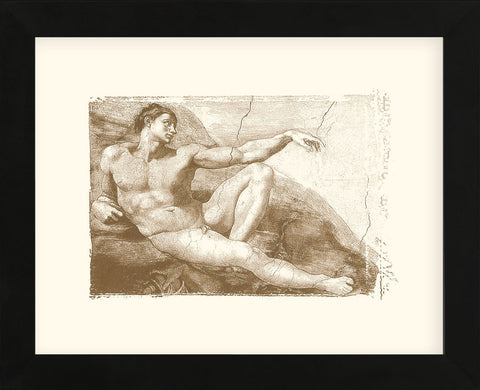Product Detail
- Overall: 16" H x 13" W x 0.75" D
- Overall Product Weight: 2.5lb.
- Material: Glass
- High-quality print on heavy paper
- Printed with vibrant, color-fast inks
- Framed in a contemporary style molding; available in black, gold, and white
- Sawtooth hanger
- Unmatted
Image is Copyrighted and Property of its respective owner
Product Detail
- Overall: 13" H x 16" W x 0.75" D
- Overall Product Weight: 2.5lb.
- Material: Glass
- High quality print on heavy paper
- Printed with vibrant, color-fast inks
- Framed in a contemporary style molding; available in black, white, and gold
- Sawtooth hanger
- Unmatted
About the Artist
As sculptor, painter, architect, poet and engineer, Michelangelo Buonarroti stands as the archetype of the Renaissance genius, with a talent that transcends time and continues to influence and inspire contemporary artists.
Michelangelo began his career in Florence in 1488, as an apprentice in the studio of Domenico Ghirlandaio. He quickly moved to the Medici Court in Florence where he gained an appreciation for classical sculpture and humanist philosophy that shaped and influenced his work. After the death of his patron, Lorenzo de Medici, the artist traveled to Bologna and Rome, continually refining his brilliant technique and establishing his reputation as a dominant force in the arts.
In May of 1508, Michelangelo accepted a commission from Pope Julius II to paint the Vatican's Sistine Chapel ceiling. Initially, Michelangelo was reluctant to accept the commission, regarding himself a sculptor, but his initial trepidations faded and he began the project in early 1509. Using the centuries-old technique of fresco, Michelangelo worked at a feverish pace under exceptionally adverse conditions. The ceiling decoration devised by Michelangelo consisted of a series of illusionistic architectural elements that frame figures and narrative scenes derived from the Old Testament. Completed four years later in 1512, the ceiling marked the summit of the artist's career as a painter and sealed his reputation as the greatest painter of the High Renaissance.
The controversial restoration of the ceiling, begun in 1980, has dramatically transformed its appearance, revealing a dazzling array of color, renewing interest in Michelangelo as a colorist. Although the artist devoted the last thirty years of his life almost exclusively to architecture, his powerful paintings remained enormously influential, and continue to stand among the supreme masterpieces of art history.





